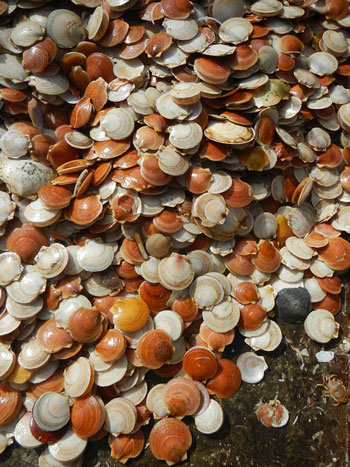Council Approves Framework 29
with 2018-2019
Four Potential Habitat Amendment Outcomes

December 07, 2017—The New England Fishery Management Council approved a sweeping package of measures for Framework Adjustment 29 to the Atlantic Sea Scallop Fishery Management Plan. The framework includes specifications for the 2018 scallop fishing year, which begins April 1, as well as default specifications for 2019. It also includes actions related to Closed Area 1 carryover pounds, the Northern Gulf of Maine Management Area, and flatfish accountability measures, among others.
Several of the actions in Framework 29 are intertwined with the approval and implementation of the Council’s Omnibus Essential Fish Habitat (EFH) Amendment 2, which is under review by the National Marine Fisheries Service (NMFS). The amendment may open EFH and groundfish closed areas that have been off limits to scallop fishing for many years. NMFS is expected to announce whether it has approved or disapproved all or part of the amendment by January 4, 2018. The comment period on the amendment closed December 5, but a final rule is not expected until later this winter or early spring.
The Habitat Amendment decisions for two areas in particular – Closed Area I and the Nantucket Lightship Area – will drive the eventual outcome of Framework 29. A substantial biomass of harvestable scallops exists in both the “sliver” portion of Closed Area I and in the western portion of the Nantucket Lightship Area, one or both of which may reopen. Important to note is that even if these areas become available through the Habitat Amendment, they do not automatically become available to the scallop fishery without additional action in Framework 29 toconvert them to scallop access areas.
Given this situation and the fact that the Council had to take final action on Framework 29 during its December meeting without knowing the Habitat Amendment outcome, it approved four preferred alternatives to cover all potential scenarios. Here are the allocations for full-time limited access permit holders.
• Closed Area 1/Nantucket Lightship West Scenario – If both of these areas become available, then 24 open area days-at-sea and six access area trips:
o One to the reconfigured Closed Area I;
o Two to Nantucket Lightship West;
o One to Nantucket Light South; and
o Two to the Mid-Atlantic Access Area.
• Nantucket Lightship West Only Scenario – If only the Nantucket Lightship Area becomes available, then 31 open area days-at-sea and five access area trips:
o Two to Nantucket Lightship West;
o One to Nantucket Lightship South; and
o Two to the Mid-Atlantic Access Area.
• Closed Area 1 Only Scenario – If only Closed Area 1 becomes available, then 23 days-at-sea and five access area trips:
o One to the reconfigured Closed Area I;
o One to Closed Area II, including the Closed Area II Extension;
o One to Nantucket Lightship South; and
o Two to the Mid-Atlantic Access Area.
• No Change Scenario: If additional access to Nantucket Lightship and/or Closed Area I does NOT become available through the Habitat Amendment, then 26 open area days-at-sea and five access area trips:
o One to Closed Area II, including the Closed Area II Extension;
o One to Nantucket Lightship South; and
If additional bottom does not become available under the Habitat Amendment, full time limited access scallopers would be allocated five access-area trips for the 2018 fishing year under the Council’s preferred alternative for this scenario – three trips in the Mid-Atlantic, one in Nantucket Lightship South, and one in Closed Area II with the Extension included, along with 26 open area days-at-sea.
o Two to the Mid-Atlantic Access Area. The Council approved an 18,000-pound possession limit for all full-time trips. Of the four scenarios described above, only one will be fully developed for implementation once the stage is set by the Habitat Amendment. The Council also voted to allocate the existing 1.64 million pounds of Closed Area I carryover if Closed Area I and/or Nantucket Lightship West are reopened. The carryover is a result of roughly 130 trips that were allocated to Closed Area I in 2012 and 2013 through a lottery system that fishermen did not take because of poor fishing conditions.
